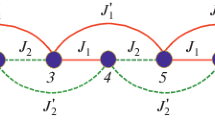Abstract
Results on the generalization of the Ising model to an arbitrary number of translations of a linear chain in an external magnetic field, taking into account various interactions between spins, are presented. An exact analytical expression has been derived for the largest eigenvalue of the Kramers–Wannier transfer matrix with a translation per two chain periods in an external magnetic field when the nearest and second neighbors are taken into account. Exact expressions have been established for the zero-temperature entropies and magnetizations at various magnitudes and signs of the exchange interactions and the magnetic field. Many of the zero-temperature entropies and zero-temperature magnetizations found are represented via the so-called mathematical ratios long known in the wonderful world of number mathematics (the golden ratio φ, the silver ratio δ, the supergolden ratio ψ, the plastic number ρ, and new (nameless) ones). A result whereby the frustrating entropies and magnetizations can be expressed via the limit of the ratio of certain number sequences without invoking the formalism of the Kramers–Wannier transfer matrix has been obtained.


















Similar content being viewed by others
REFERENCES
I. Syozi and S. Naya, Prog. Theor. Phys. 23, 374 (1960).
I. Syozi and S. Naya, Prog. Theor. Phys. 24, 829 (1960).
I. Syozi, Phase Transitions and Critical Phenomena, Ed. by C. Domb and M. S. Green (Academic, New York, 1972), Vol. 1.
L. Onsager, Phys. Rev. 65, 117 (1944).
T. Utiyama, Prog. Theor. Phys. 6, 907 (1951).
G. H. Wannier, Phys. Rev. 79, 357 (1950).
R. M. F. Houtappel, Prog. Theor. Phys. 16, 425 (1950).
K. Kanô and S. Naya, Prog. Theor. Phys. 10, 158 (1953).
E. S. Tsuvarev, F. A. Kassan-Ogly, and A. I. Proshkin, J. Exp. Theor. Phys. 131, 447 (2020).
E. S. Tsuvarev and F. A. Kassan-Ogly, J. Exp. Theor. Phys. 131, 976 (2020).
R. J. Baxter, Exactly Solved Models in Statistical Mechanics (Academic Press, New York, 1982).
H. A. Kramers and G. H. Wannier, Phys. Rev. 60, 252 (1941).
H. A. Kramers and G. H. Wannier, Phys. Rev. 60, 263 (1941).
A. V. Zarubin, F. A. Kassan-Ogly, A. I. Proshkin, and A. E. Shestakov, J. Exp. Theor. Phys. 128, 778 (2019).
F. A. Kassan-Ogly, Phase Trans. 74, 353 (2001).
E. Ising, Zeitschr. Phys. 21, 253 (1925).
Q. Wu, Math. Comput. 79, 2387 (2010).
D. Lind, J. Number Theory 40, 211 (1992).
D. W. Boyd, Math. Comput. 45, 243 (1985).
N. J. A. Sloane, A Handbook of Integer Sequences (Academic, New York, 1973).
N. J. A. Sloane and S. Plouffe, The Encyclopedia of Integer Sequences, 1st ed. (Academic, New York, 1995).
V. E. Hoggatt, Jr., Fibonacci and Lucas Numbers (Houghton Mifflin, Boston, 1969).
J. Allouche and T. Johnson, in Proceedings of the Conference JIM96 (Journés d’Informatique Musicale), Ile de Tatihou, France, 1996.
X. Lin, Symmetry 13, 12 (2021).
M. Bicknell, Fibonacci Quart. 13, 345 (1975).
R. P. M. Vieira, F. R. V. Alves, and P. M. M. C. Catarino, Int. J. Trends Math. Educ. Res. 3, 8 (2020).
W. Adams and D. Shanks, Math. Comput. 39, 255 (1982).
Funding
The work was performed within the State assignment of the Ministry of Science and Higher Education of the Russian Federation (theme “Quantum,” no. AAAA-A18-118020190095-4 and “Alloys,” no. AAAA-A19-119070890020-3) and under partial support of the Ural branch of the Russian Academy of Sciences (project no. 18-2-2-11).
Author information
Authors and Affiliations
Corresponding authors
Additional information
Translated by V. Astakhov
Rights and permissions
About this article
Cite this article
Tsuvarev, E.S., Kassan-Ogly, F.A. Generalized Ising Model in a Magnetic Field. J. Exp. Theor. Phys. 133, 191–205 (2021). https://doi.org/10.1134/S1063776121080112
Received:
Revised:
Accepted:
Published:
Issue Date:
DOI: https://doi.org/10.1134/S1063776121080112




